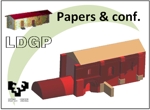Virtual Reconstruction of the Ancient State of a Ruined Church

Ver/
Fecha
2012-11Metadatos
Mostrar el registro completo del ítem
GKINTZOU Christina, GEORGOPOULOS Andreas, VALLE MELÓN, José Manuel. RODRÍGUEZ MIRANDA, Álvaro. Virtual Reconstruction of the Ancient State of a Ruined Church. Progress in Cultural Heritage Preservation. 4th International Conference, EuroMed 2012, Limassol, Cyprus, October 29 – November 3, 2012. Proceedings. Lecture Notes in Computer Science, Vol. 7616. Springer Berlin Heidelberg. ISBN: 978-3-642-34233-2 (print). 978-3-642-34234-9 (online). 2012. pp. 551-567. DOI: 10.1007/978-3-642-34234-9_57
Resumen
[EN] Three dimensional virtual models can represent both the existing and the already destroyed architectural heritage. This project deals with the 3D reconstruction and representation of the church of San Prudencio's Monastery in La Rioja (Spain) as it is supposed to be during the 15th century. Today the monument is totally in ruins; hence severe reconstruction was needed. This is an exemplary project of close collaboration of different scientific fields. Surveying data of the monument itself and of the wider area around it, but also architectural and archaeological data were collected in situ. It was not possible from the current situation to conclude about the exact form, style and representation of the monument; hence a large part of the project is based on assumptions which have a sound scientific base. Because of the multisource data there was need to define specific criteria by which every data source was evaluated. [ES] Los modelos tridimensionales pueden representar tanto los elementos patrimoniales existentes como los ya han dejado de existir. En este proyecto se trata la reconstrucción tridimensional de la iglesia del Monasterio de San Prudencio de Monte Laturce (Clavijo, La Rioja, España) tal como se supone que fue durante el siglo XV.
En la actualidad el edificio está arruinado por lo que ha sido necesario realizar una importante reconstrucción virtual basad en hipótesis que han requerido la colaboración de técnicos de diferentes áreas de conocimiento, por ejemplo,
se ha contado con un levantamiento topográfico de los restos y del área circundante, datos sobre los materiales e hipótesis arqueológicas y arquitectónicas.
Dado que existe información de múltiples fuentes, ha sido necesario incorporar un conjunto de criterios de selección y evaluación de las mismas.
 Volver
Volver